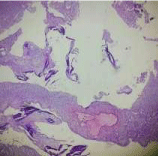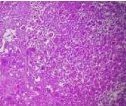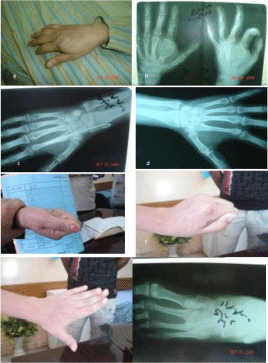Case Report
Replacement of Destroyed Metacarpal Bones by Benign Tumors with Autografting Complete Metatarsal Bones: A Report of Two Cases
Al Bayati MA*, Al Janabi SH, Mohammed HL and Al-Khishali J
Al Wasity Teaching Hospital, Baghdad, Iraq
*Corresponding author: Al Bayati MA, Al Wasity Teaching Hospital, Baghdad, Iraq
Published: 15 Apr, 2017
Cite this article as: Al Bayati MA, Al Janabi SH,
Mohammed HL, Al-Khishali J.
Replacement of Destroyed Metacarpal
Bones by Benign Tumors with
Autografting Complete Metatarsal
Bones: A Report of Two Cases. Ann
Clin Case Rep. 2017; 2: 1336.
Abstract
Aggressive benign tumors of the hand are rare; they occur in young age group and can be destructive to the whole bone. En bloc removal is advised to prevent recurrence. Replacement of the removed bone was done by several methods. We present a report of two cases; one a child with aneurismal bone cyst, and an adult woman with aggressive giant cell tumor. Both bones removed completely and replaced by the third metatarsal bone of the left foot. The child after 18 months and the women after 42 months of follow up, preserved good function of the hand and did not show any recurrence or morbidity at the donor site. This method is a good choice of treatment.
Keywords: Aneurismal bone cyst; Giant cell tumors; Hand tumors; Metacarpal replacement
Introduction
Aggressive benign tumors of the hand are rare conditions. It occurs at young age, can be primarily in the bones or in the soft tissue of the hand [1]. Giant Cell Tumor (GCT) and Aneurismal Bone Cyst (ABC) may give the same clinical and radiological pictures. GCT is a rare benign bone lesion most often found in the extremities of women in the third and fourth decades of life. Surgery is the mainstay of treatment and usually consists of intralesional curettage. Local control rates range from 80% to 90% after this procedure. ABC is a reactive lesion of bone, locally destructive and not considered as a true neoplasm. Most common in proximal humerus, around the knee and spine. Treated by curettage and bone graft with a recurrence rate up to 20%. Aggressive inaccessible lesions may be treated by arterial embolization or low dose radiation [2]. Aggressive ABC and GCT occur in the metacarpal bones, grow fast and tend to recur after curettage removal. They can be multicentral and destroy the whole bone and the Metatarsophalangeal Joints (MPJ) [3-5]. These conditions can affect greatly the function of the hand. Drastic treatment is by ray amputation which leaves immense dysfunction. Complete en bloc removal of the affected bone with adjacent soft tissue and replacement provide cure, preservation of function and cosmoses of the hand [6,7]. Replacement of the removed metacarpal can be done by different modalities; autografting with metatarsal bone, [6-8] vascular or non-vascular fibular graft [9] silicone end prosthesis and iliac crest graft [10]. A small subset of patients with incompletely resectable GCT or with lesions that are surgically inaccessible may be treated with moderate-dose radiotherapy (45-50 Gy) and have a 65% to 80% likelihood of being locally controlled [11]. We report 2 cases of aggressive ABC and GCT of the second metacarpal with gross destruction of bone, removed and replaced completely with the third metatarsal bone successfully.
Case Presentation
Case 1
Eight years old boy presented with painful swelling of the left hand in the area of the second
metacarpal bone of three months duration. The swelling was spontaneous with no history of
previous trauma or infection in the hand. On physical examination, hard oval swelling on the
dorsum of the hand in the second metacarpal area measuring 3 cm x 2 cm. The mass was moderately
tender on deep palpation. The range of movement of the second MPJ was moderately affected, and
the neurovascular bundle was intact. Radiological examination revealed a large lytic lesion involving
the whole second metacarpal bone, expansile ballooning in shape reported as aneurismal bone cyst
(Figure 1).
Decision was made to do en bloc removal and replacement with complete third metatarsal bone. Dorsal approach was appropriate, lazy S incision done,
separation and isolation of the extensor tendons, then removal of
the whole MC with its periosteum. The harvested metatarsal, with
its periosteum, was implanted at the site of the removed metacarpal
and fixed with intramedullary K wire for eight weeks. Care was taken
to reconstruct the MPJ. Plaster of Paris (POP) volar splint keeping
slight dorsiflexion of the wrist and 80 degree flexion of the MPG
kept for 8 weeks. The K wire was removed by the end of 12 weeks
when index mobilization started. Histopathologic examination of the
excised metacarpal revealed aneurismal bone cyst (Figure 2). After
18 months follow up, the graft was completely incorporated and the
second MPJ movements were satisfactory, no recurrence at the site,
normal appearance of the hand and no morbidity at the donor foot.
Case 2
Thirty six years old housewife referred with a painful swelling of
her left hand for six months. She carried a histopathological report
of giant cell tumor from a biopsy of the second metacarpal bone
(Figure 3). Radiological examination showed complete destruction of
the bone. Treatment was by en bloc removal of the affected second
metacarpal bone with replacement by the left third metatarsal bone placed and fixed by K. wire for 12 weeks. Dorsal approach was used
as well, care taken to reconstruct the second MPJ. Rehabilitation
by passive and active movement of the joint after three weeks from
surgery. After 42 months the hand was free of recurrence and
maintained good function with no morbidity at the donor left foot
(Figure 4).
Figure 1
Figure 2
Figure 2
Clinical photo of case No. 1 Aneurismal bone cyst, section showing
dilated vascular channels with hemorrhage and scattered multinucleated
giant cells.
Figure 3
Figure 3
Clinical photo case No. 2 GCT section shows heavy infiltration by
osteoclastic multinucleated giant cells in a compact fashion surrounded by
mono-nuclear stromal cells.
Figure 4
Figure 4
Clinical photo of case No. 2, (a) Swelling of the hand. (b) Plain xray.
(c) Metatarsal replaced and fixed in place. (d) 12 weeks. postoperative
fully incorporated metatarsal. (e,f,g) 12 weeks postoperative function of the
hand. (h) Donor site x-ray.
Discussion
Aggressive benign tumors of the hand are rare; they can destroy the whole metacarpal bone. They occur in young age group, grossly affecting the function of the hand. These tumors can be multicentric and tend to recur after local removal [4,7,9,12]. En bloc resection is the preferred method to ensure the cure of the disease. To preserve the function of the hand, replacement of the removed metacarpal is done by several methods; free fibular graft, vascular iliac crest strut, cement spacer, all with or without endoprosthesis, and autotrasplant of metatarsal bone [6-9,13-15]. We presented two cases of successful autotransplant of metatarsal bone for a completely destroyed second metacarpal with the MPJ. The first was for a child with aneurismal bone cyst, and the second for a woman with aggressive giant cell tumor. After 18-42 months of follow up this method proved to cure the disease with retrieval of a good satisfactory function as well as the cosmetic appearance of the hand. Mikkelsen OA and Menon J used metatarsal head to replace destroyed MPJ in rheumatoid patients with satisfactory results [6,7]. Saikat Sau also used metatarsals to replace destroyed metacarpal bones by giant cell tumors with satisfactory functional results [16]. Because of the rarity of theses tumors, studies of large number of patients are not available, however many case report studies have been published consistent with our results. We recommend metatarsal replacement as it is more physiological and less demanding. In addition, it provides cure with satisfactory function and cosmoses.
References
- Nielsen GP, Fletcher CD, Smith MA, Rybak L, Rosenberg AE. Soft tissue aneurysmal bone cyst: a clinicopathologic study of five cases. Am J Surg Pathol. 2002;26(1):64-9.
- James H Calandruccio, Mark T Jobe. Tumors and timorous conditions of the hand. S.Terry Canale, James H beaty (eds.). Campbell's Operative Orthopaedics. 12th ed. Canada: Elsevier Mosby; 2013. 3661-3692.
- Dahlin DC. Giant-cell-bearing lesions of bone of the hands. Hand Clin. 1987;3(2):291-7.
- Goldenberg RR, Campbell CJ, Bonfiglio M. Giant-cell tumor of bone. An analysis of two hundred and eighteen cases. J Bone Joint Surg Am. 1970;52(4):619-64.
- Athanasian EA, Wold LE, Amadio PC. Giant cell tumors of the bones of the hand. J Hand Surg Am. 1997;22(1):91-8.
- Mikkelsen OA. Replacement of destroyed metacarpal heads by autografting metatarsal heads. J Hand Surg Br. 1984;9(3):337-9.
- Menon J. Reconstruction of the metacarpophalangeal joint with autogenous metatarsal. J Hand Surg Am. 1983;8(4):443-6.
- Kotwal PP, Nagaraj C, Gupta V. Vascularised joint transfer in the management of recurrent giant cell tumour of the second metacarpal. J Hand Surg Eur Vol. 2008;33(3):314-6.
- Jones NF, Dickinson BP, Hansen SL. Reconstruction of an entire metacarpal and metacarpophalangeal joint using a fibular osteocutaneous free flap and silicone arthroplasty. J Hand Surg Am. 2012;37(2):310-5.
- Kabul C Saikia, Sanjeev K Bhuyan, Firoz Ahmed, Debashish Chandra. Gaint cell tumor of the metacarpal bones. Indian J Orthop. 2011;45(5):475- 8.
- Mendenhall WM, Zlotecki RA, Scarborough MT, Gibbs CP, Mendenhall NP. Giant cell tumor of bone. Am J Clin Oncol. 2006;29(1):96-9.
- Averill RM, Smith RJ, Campbell CJ. Giant-cell tumors of the bones of the hand. J Hand Surg Am. 1980;5(1):39-50.
- Gurinden Singh Gosal, Avneet Boparai, Gunpreet Singh Makkar. New Technique of Reconstruction of Metacarpal After Enblock Resection of The Metacarpal for Giant Cell Tumor of Bone. Int J Sci Res. 2015;4(5).
- Athanasian EA, Bishop AT, Amadio PC. Autogenous fibular graft and silicone implant arthroplasty following resection of giant cell tumor of metacarpal: a report of two cases. J Hand surg Am. 1997;22(3):504-7.
- Otto A. Mikkelelsen. Replacement of Destroyed Metacarpal Heads by Autografting Metatarsal heads. J Hand Surg Br. 1984;9(3):337-9.
- Saikat Sau. Reconstruction of metacarpal bone giant cell tumor by metatarsal bone. Int J Res Orthop. 2016;2(1):23-35.




